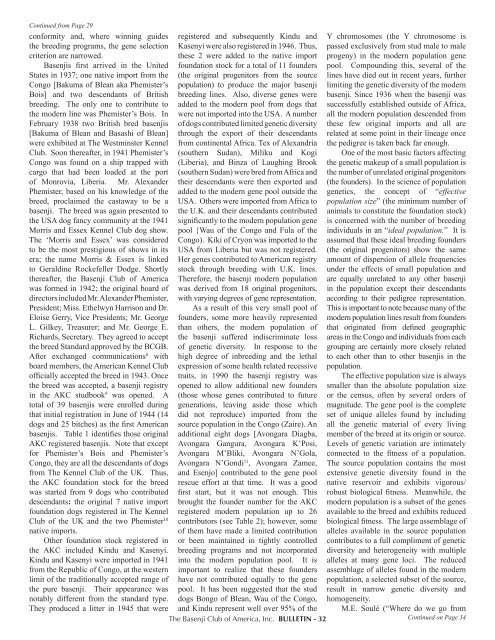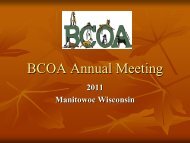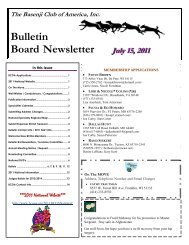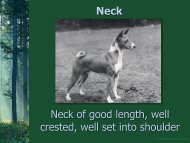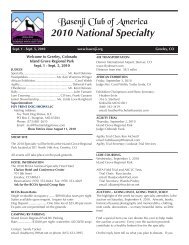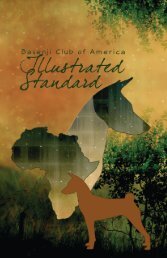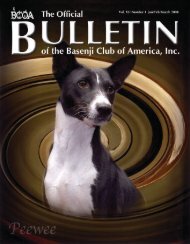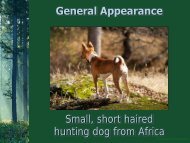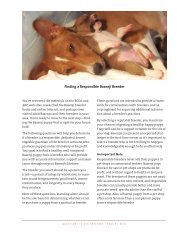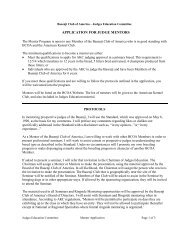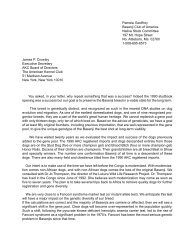BCOA Bulletin January-February-March 2007 - the Basenji Club of ...
BCOA Bulletin January-February-March 2007 - the Basenji Club of ...
BCOA Bulletin January-February-March 2007 - the Basenji Club of ...
You also want an ePaper? Increase the reach of your titles
YUMPU automatically turns print PDFs into web optimized ePapers that Google loves.
conformity and, where winning guides<br />
<strong>the</strong> breeding programs, <strong>the</strong> gene selection<br />
criterion are narrowed.<br />
<strong>Basenji</strong>s first arrived in <strong>the</strong> United<br />
States in 1937; one native import from <strong>the</strong><br />
Congo [Bakuma <strong>of</strong> Blean aka Phemister’s<br />
Bois] and two descendants <strong>of</strong> British<br />
breeding. The only one to contribute to<br />
<strong>the</strong> modern line was Phemister’s Bois. In<br />
<strong>February</strong> 1938 two British bred basenjis<br />
[Bakuma <strong>of</strong> Blean and Basashi <strong>of</strong> Blean]<br />
were exhibited at The Westminster Kennel<br />
<strong>Club</strong>. Soon <strong>the</strong>reafter, in 1941 Phemister’s<br />
Congo was found on a ship trapped with<br />
cargo that had been loaded at <strong>the</strong> port<br />
<strong>of</strong> Monrovia, Liberia. Mr. Alexander<br />
Phemister, based on his knowledge <strong>of</strong> <strong>the</strong><br />
breed, proclaimed <strong>the</strong> castaway to be a<br />
basenji. The breed was again presented to<br />
<strong>the</strong> USA dog fancy community at <strong>the</strong> 1941<br />
Morris and Essex Kennel <strong>Club</strong> dog show.<br />
The ‘Morris and Essex’ was considered<br />
to be <strong>the</strong> most prestigious <strong>of</strong> shows in its<br />
era; <strong>the</strong> name Morris & Essex is linked<br />
to Geraldine Rockefeller Dodge. Shortly<br />
<strong>the</strong>reafter, <strong>the</strong> <strong>Basenji</strong> <strong>Club</strong> <strong>of</strong> America<br />
was formed in 1942; <strong>the</strong> original board <strong>of</strong><br />
directors included Mr. Alexander Phemister,<br />
President; Miss. E<strong>the</strong>lwyn Harrison and Dr.<br />
Eloise Gerry, Vice Presidents; Mr. George<br />
L. Gilkey, Treasurer; and Mr. George E.<br />
Richards, Secretary. They agreed to accept<br />
<strong>the</strong> breed Standard approved by <strong>the</strong> BCGB.<br />
After exchanged communications<br />
The <strong>Basenji</strong> <strong>Club</strong> <strong>of</strong> America, Inc. BULLETIN - 32<br />
8 with<br />
board members, <strong>the</strong> American Kennel <strong>Club</strong><br />
<strong>of</strong>ficially accepted <strong>the</strong> breed in 1943. Once<br />
<strong>the</strong> breed was accepted, a basenji registry<br />
in <strong>the</strong> AKC studbook9 was opened. A<br />
total <strong>of</strong> 39 basenjis were enrolled during<br />
that initial registration in June <strong>of</strong> 1944 (14<br />
dogs and 25 bitches) as <strong>the</strong> first American<br />
basenjis. Table 1 identifies those original<br />
AKC registered basenjis. Note that except<br />
for Phemister’s Bois and Phemister’s<br />
Congo, <strong>the</strong>y are all <strong>the</strong> descendants <strong>of</strong> dogs<br />
from The Kennel <strong>Club</strong> <strong>of</strong> <strong>the</strong> UK. Thus,<br />
<strong>the</strong> AKC foundation stock for <strong>the</strong> breed<br />
was started from 9 dogs who contributed<br />
descendants: <strong>the</strong> original 7 native import<br />
foundation dogs registered in The Kennel<br />
<strong>Club</strong> <strong>of</strong> <strong>the</strong> UK and <strong>the</strong> two Phemister10 registered and subsequently Kindu and<br />
Kasenyi were also registered in 1946. Thus,<br />
<strong>the</strong>se 2 were added to <strong>the</strong> native import<br />
foundation stock for a total <strong>of</strong> 11 founders<br />
(<strong>the</strong> original progenitors from <strong>the</strong> source<br />
population) to produce <strong>the</strong> major basenji<br />
breeding lines. Also, diverse genes were<br />
added to <strong>the</strong> modern pool from dogs that<br />
were not imported into <strong>the</strong> USA. A number<br />
<strong>of</strong> dogs contributed limited genetic diversity<br />
through <strong>the</strong> export <strong>of</strong> <strong>the</strong>ir descendants<br />
from continental Africa. Tex <strong>of</strong> Alexandria<br />
(sou<strong>the</strong>rn Sudan), Miliku and Kogi<br />
(Liberia), and Binza <strong>of</strong> Laughing Brook<br />
(sou<strong>the</strong>rn Sudan) were bred from Africa and<br />
<strong>the</strong>ir descendants were <strong>the</strong>n exported and<br />
added to <strong>the</strong> modern gene pool outside <strong>the</strong><br />
USA. O<strong>the</strong>rs were imported from Africa to<br />
<strong>the</strong> U.K. and <strong>the</strong>ir descendants contributed<br />
significantly to <strong>the</strong> modern population gene<br />
pool {Wau <strong>of</strong> <strong>the</strong> Congo and Fula <strong>of</strong> <strong>the</strong><br />
Congo). Kiki <strong>of</strong> Cryon was imported to <strong>the</strong><br />
USA from Liberia but was not registered.<br />
Her genes contributed to American registry<br />
stock through breeding with U.K. lines.<br />
Therefore, <strong>the</strong> basenji modern population<br />
was derived from 18 original progenitors,<br />
with varying degrees <strong>of</strong> gene representation.<br />
As a result <strong>of</strong> this very small pool <strong>of</strong><br />
founders, some more heavily represented<br />
than o<strong>the</strong>rs, <strong>the</strong> modern population <strong>of</strong><br />
<strong>the</strong> basenji suffered indiscriminate loss<br />
<strong>of</strong> genetic diversity. In response to <strong>the</strong><br />
high degree <strong>of</strong> inbreeding and <strong>the</strong> lethal<br />
expression <strong>of</strong> some health related recessive<br />
traits, in 1990 <strong>the</strong> basenji registry was<br />
opened to allow additional new founders<br />
(those whose genes contributed to future<br />
generations, leaving aside those which<br />
did not reproduce) imported from <strong>the</strong><br />
source population in <strong>the</strong> Congo (Zaire). An<br />
additional eight dogs [Avongara Diagba,<br />
Avongara Gangura, Avongara K’Posi,<br />
Avongara M’Bliki, Avongara N’Gola,<br />
Avongara N’Gondi<br />
native imports.<br />
O<strong>the</strong>r foundation stock registered in<br />
<strong>the</strong> AKC included Kindu and Kasenyi.<br />
Kindu and Kasenyi were imported in 1941<br />
from <strong>the</strong> Republic <strong>of</strong> Congo, at <strong>the</strong> western<br />
limit <strong>of</strong> <strong>the</strong> traditionally accepted range <strong>of</strong><br />
<strong>the</strong> pure basenji. Their appearance was<br />
notably different from <strong>the</strong> standard type.<br />
They produced a litter in 1945 that were<br />
11 Continued from Page 29<br />
Y chromosomes (<strong>the</strong> Y chromosome is<br />
passed exclusively from stud male to male<br />
progeny) in <strong>the</strong> modern population gene<br />
pool. Compounding this, several <strong>of</strong> <strong>the</strong><br />
lines have died out in recent years, fur<strong>the</strong>r<br />
limiting <strong>the</strong> genetic diversity <strong>of</strong> <strong>the</strong> modern<br />
basenji. Since 1936 when <strong>the</strong> basenji was<br />
successfully established outside <strong>of</strong> Africa,<br />
all <strong>the</strong> modern population descended from<br />
<strong>the</strong>se few original imports and all are<br />
related at some point in <strong>the</strong>ir lineage once<br />
<strong>the</strong> pedigree is taken back far enough.<br />
One <strong>of</strong> <strong>the</strong> most basic factors affecting<br />
<strong>the</strong> genetic makeup <strong>of</strong> a small population is<br />
<strong>the</strong> number <strong>of</strong> unrelated original progenitors<br />
(<strong>the</strong> founders). In <strong>the</strong> science <strong>of</strong> population<br />
genetics, <strong>the</strong> concept <strong>of</strong> “effective<br />
population size” (<strong>the</strong> minimum number <strong>of</strong><br />
animals to constitute <strong>the</strong> foundation stock)<br />
is concerned with <strong>the</strong> number <strong>of</strong> breeding<br />
individuals in an “ideal population.” It is<br />
assumed that <strong>the</strong>se ideal breeding founders<br />
(<strong>the</strong> original progenitors) show <strong>the</strong> same<br />
amount <strong>of</strong> dispersion <strong>of</strong> allele frequencies<br />
under <strong>the</strong> effects <strong>of</strong> small population and<br />
are equally unrelated to any o<strong>the</strong>r basenji<br />
in <strong>the</strong> population except <strong>the</strong>ir descendants<br />
according to <strong>the</strong>ir pedigree representation.<br />
This is important to note because many <strong>of</strong> <strong>the</strong><br />
modern population lines result from founders<br />
that originated from defined geographic<br />
areas in <strong>the</strong> Congo and individuals from each<br />
grouping are certainly more closely related<br />
to each o<strong>the</strong>r than to o<strong>the</strong>r basenjis in <strong>the</strong><br />
population.<br />
The effective population size is always<br />
smaller than <strong>the</strong> absolute population size<br />
or <strong>the</strong> census, <strong>of</strong>ten by several orders <strong>of</strong><br />
magnitude. The gene pool is <strong>the</strong> complete<br />
set <strong>of</strong> unique alleles found by including<br />
all <strong>the</strong> genetic material <strong>of</strong> every living<br />
member <strong>of</strong> <strong>the</strong> breed at its origin or source.<br />
Levels <strong>of</strong> genetic variation are intimately<br />
connected to <strong>the</strong> fitness <strong>of</strong> a population.<br />
, Avongara Zamee, The source population contains <strong>the</strong> most<br />
and Esenjo] contributed to <strong>the</strong> gene pool extensive genetic diversity found in <strong>the</strong><br />
rescue effort at that time. It was a good native reservoir and exhibits vigorous/<br />
first start, but it was not enough. This robust biological fitness. Meanwhile, <strong>the</strong><br />
brought <strong>the</strong> founder number for <strong>the</strong> AKC modern population is a subset <strong>of</strong> <strong>the</strong> genes<br />
registered modern population up to 26 available to <strong>the</strong> breed and exhibits reduced<br />
contributors (see Table 2); however, some biological fitness. The large assemblage <strong>of</strong><br />
<strong>of</strong> <strong>the</strong>m have made a limited contribution alleles available in <strong>the</strong> source population<br />
or been maintained in tightly controlled contributes to a full compliment <strong>of</strong> genetic<br />
breeding programs and not incorporated diversity and heterogeneity with multiple<br />
into <strong>the</strong> modern population pool. It is alleles at many gene loci. The reduced<br />
important to realize that <strong>the</strong>se founders assemblage <strong>of</strong> alleles found in <strong>the</strong> modern<br />
have not contributed equally to <strong>the</strong> gene population, a selected subset <strong>of</strong> <strong>the</strong> source,<br />
pool. It has been suggested that <strong>the</strong> stud result in narrow genetic diversity and<br />
dogs Bongo <strong>of</strong> Blean, Wau <strong>of</strong> <strong>the</strong> Congo, homogeneity.<br />
and Kindu represent well over 95% <strong>of</strong> <strong>the</strong> M.E. Soulé (“Where do we go from<br />
Continued on Page 34


